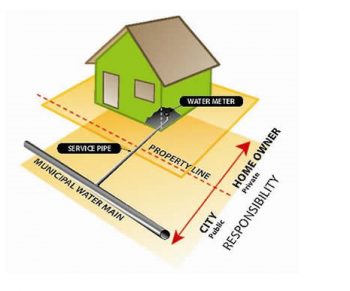
Water produced at the City’s drinking water treatment plants does not contain lead. Lead can be found in:
As these items corrode and breakdown, lead can enter drinking water.
Apartment and other buildings with more than six units do not have lead water service pipes, regardless of age. Lead is too soft to handle the pressure needed to provide water to these types of buildings.
Lead can affect how the brain and nervous system grows. According to Toronto Public Health, those most at risk include:
Toronto Public Health strongly recommends replacing your side of the lead service pipe at the same time that the City is replacing its side. For options, see section below called What to Do if you Have Lead Pipes. Cutting the pipe to replace just one portion can cause particles of lead to enter drinking water, which can lead to a temporary spike in lead levels.
In 2014, the City began adding phosphate to the drinking water treatment process. Corrosion control is mandated and approved by the Ministry of the Environment, Conservation and Parks (MECP). It is the treatment, or the addition, of phosphate to the drinking water process. Phosphate forms a protective coating inside all pipes and household plumbing fixtures, which helps to reduce the potential for lead to enter tap water. Ongoing regulated tap water test results show lower lead levels compared with the lead levels measured prior to initiating corrosion control treatment. Learn more about the City’s Corrosion Control Plan.
In 2011, Toronto City Council approved the Lead in Drinking Water Mitigation Strategy, a multi-pronged approach aimed at protecting public health by reducing lead in drinking water. Read the latest annual update on the City’s Lead in Drinking Water Mitigation Strategy.

The water service pipe delivers water into a building. This pipe is divided into two parts.
Lead pipes affect residential homes. There are approximately 437,000 residential customers in the City of Toronto. Of these, it is estimated that just under 16,000 City-owned lead water service pipes remain.
A licensed plumber can determine if your water service pipe is lead. They will likely need to enter your basement to make a visual inspection of the pipe entering your home near the water meter.
Testing is the only way to know if your water has lead. The City also offers free lead testing to help determine if you have lead in your water. You can also contact Toronto Public Health or 311 for information about testing options.
Toronto Public Health recommends those with lead pipes take the following actions:
It is recommended that the City replace the City-owned portion of the pipe (from the watermain to the property line) and the resident replace the private portion (from the property line into the home) at the same time. Cutting the pipe to replace just one side can cause particles of lead to enter drinking water, which can cause a temporary spike in lead levels. Residents who commit to replacing their side of the pipe can apply to have the City replace its side through the Priority Lead Water Service Replacement Program.
Residents may also have the opportunity to replace their portion of the service pipe when the City has a project to replace the watermain or City side of the service line. For example, the City’s Capital Water Service Replacement Program replaces the City-owned portion of substandard drinking water pipes during planned construction projects, such as road, sewer and watermain work.
If it has been a few hours since you have used water, run the cold water tap for at least five minutes. This will pull fresh water from the watermain into the pipes.
Use cold water for drinking, cooking and preparing baby formula. Lead in pipes dissolves more readily into hot water than into cold water. Cold water is less likely to contain lead after flushing the pipes, compared to hot water.
Use a NSF-053 certified water filter to remove lead. Make sure the filter is designed for drinking water and is replaced regularly according to manufacturer’s recommendations.
Look for filters certified by the National Sanitation Foundation (NSF) for lead removal and reduction.
You can install an end-of-tap filter on the tap you use most often for cooking or for water to drink. The City offers a faucet filter rebate to eligible homeowners.
You can also use a pitcher-style filter.
If you have a baby at home and are breastfeeding, continue to breastfeed your baby. The amount of lead in breast milk is much lower than in tap water if you have a lead service pipe. If you are feeding your baby formula, use cold filtered tap water. Until you have a filter, consider using bottled water for making baby formula, or ready-to-feed formula.
In 2011, Toronto City Council approved the Lead in Drinking Water Mitigation Strategy, a multi-pronged approach aimed at protecting public health by reducing lead in drinking water. Components of the strategy include:
Residents in Toronto can submit a drinking water sample to be tested for lead levels free of charge at one of Toronto Water’s accredited labs. Find out how to get a lead testing kit and how it works.
The City has enhanced its drinking water treatment process to add phosphate, which forms a protective coating inside all pipes and reduces the contact between drinking water and lead surfaces. Learn more about the City’s Corrosion Control Plan.
Each year, the City replaces the City-owned portion of water service pipes through the programs listed below. Many of these pipes will be lead.
The City provides a free faucet filter for lead removal to homeowners whenever the City-owned portion of a lead water service is replaced. Toronto Public Health also distributes free filters to participants of the Canada Prenatal Nutrition Program.
Residents that have lead pipes can apply for a rebate to help purchase an NSF-053 certified filter for lead removal and/or replacement cartridges if they meet all of the following criteria: